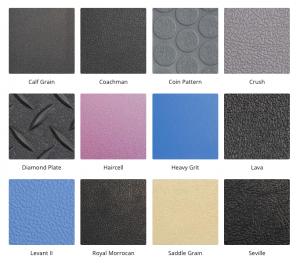Let’s talk textures. Texture is one of the areas where thermoforming offers a distinct advantage over other plastic molding processes like injection molding, rotational molding, and blow molding. When it comes to thermoformed plastic part textures, the process is much simpler, more flexible, and often far more cost-effective. Unlike fiberglass or those other plastic molding methods, thermoformed (or vacuum-formed) parts don’t rely on the mold surface to create the texture. Instead, the texture is already present on the thermoformable sheet before it ever touches the mold.
In processes like injection molding or fiberglass molding, if a specific texture is needed, the mold itself must be chemically etched or physically altered to reflect the desired surface finish. That can be a time-consuming and expensive undertaking. Even worse, once the mold surface has been changed, reversing that decision can be incredibly difficult—if not impossible. Changing mold textures often means removing material from the mold, which could compromise tool tolerances and part fit. With parts that require tight tolerances, this can lead to fit and finish issues.
In contrast, thermoformed plastic part textures are determined entirely by the surface of the plastic sheet used in the process. Thermoplastic sheet suppliers offer materials with pre-embossed textures. If a customer wants to change the texture of their part, it’s as simple as requesting a different textured sheet from the supplier. There is typically no additional cost or tooling delay to make this change, which gives designers and manufacturers tremendous flexibility when it comes to aesthetics and surface performance.
Common textures available for thermoformed parts include haircell (very popular in consumer and industrial products), smooth, matte, satin, levant, seville, calf, Moroccan, leatherette, safety grip, deep groove, and pyramid textures, among others. Each of these textures can influence the final appearance and function of the part—whether that’s increasing surface grip, reducing gloss, hiding wear, or simulating the look of leather or fabric. This makes thermoformed plastic part textures a powerful design tool for manufacturers across many industries, including automotive, medical, and recreational equipment.
Another major benefit is the ability to apply decorative laminates on top of the textured sheet. Just like textures, laminates can dramatically change the look and feel of the final product—offering options like metal flake, woodgrain, carbon fiber, camouflage, and more. The combination of texture and laminate allows for high-end visual effects without the cost and complexity of secondary finishing operations. We’ll dive deeper into laminates in a future blog post.
If you’re exploring new finishes for your project and want to learn more about the wide range of thermoformed plastic part textures available, give us a call. Arrowhead can help you evaluate your options and choose the best surface to match your product’s design, performance, and cost goals.


